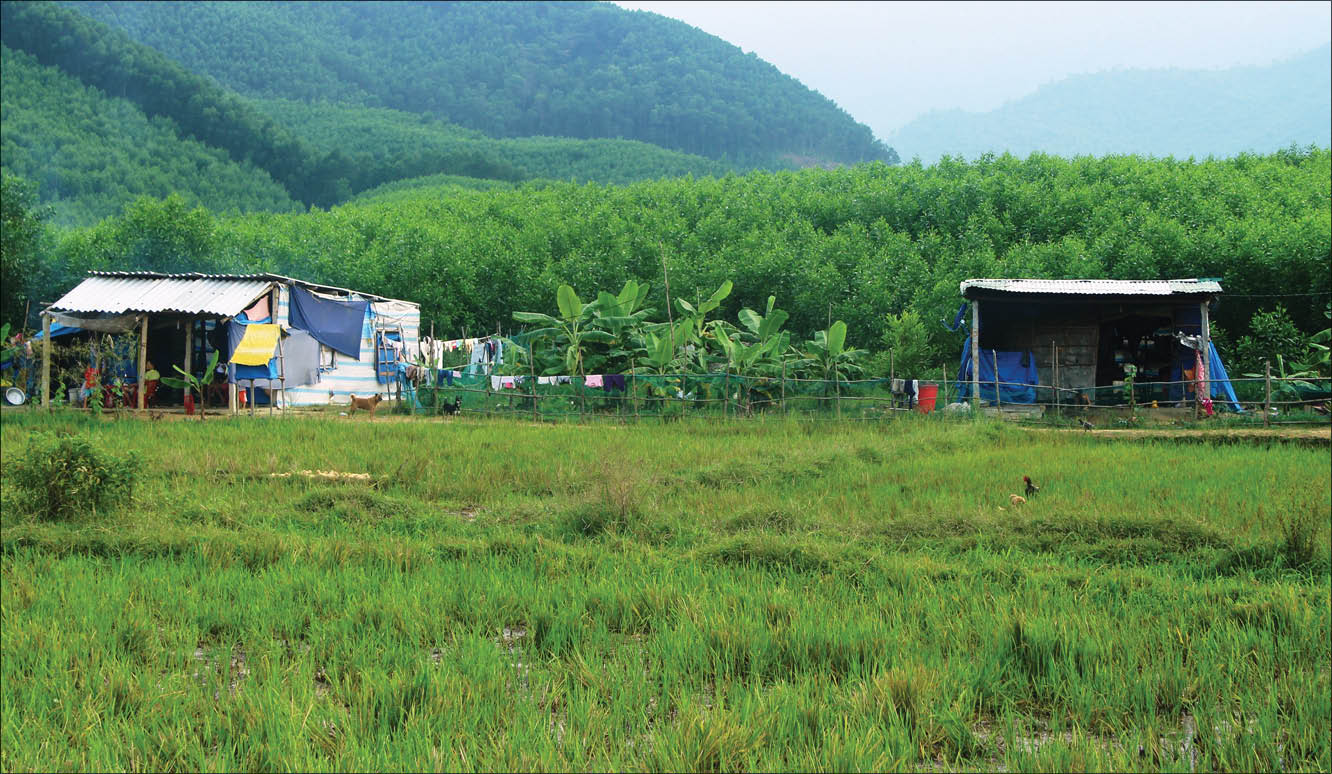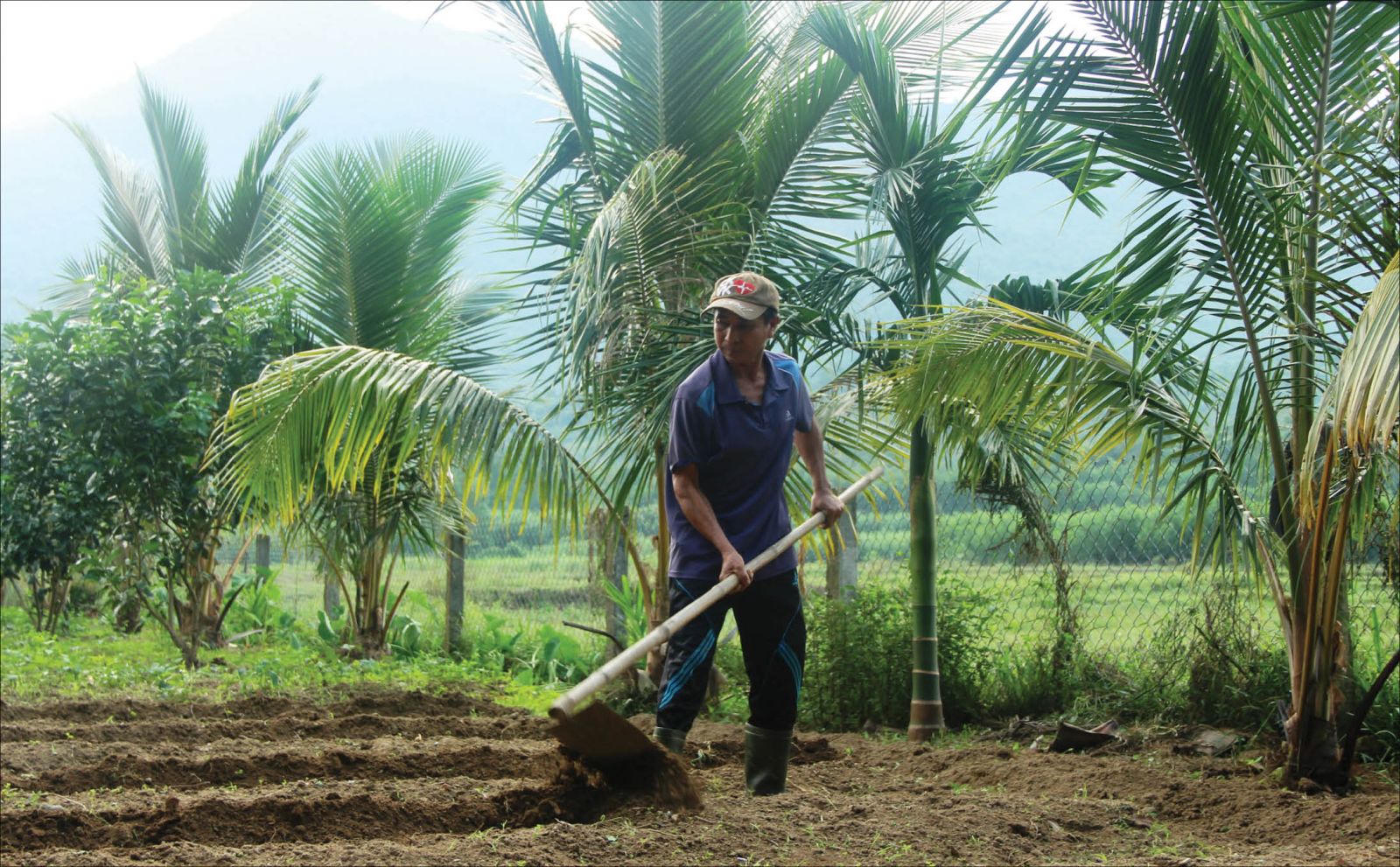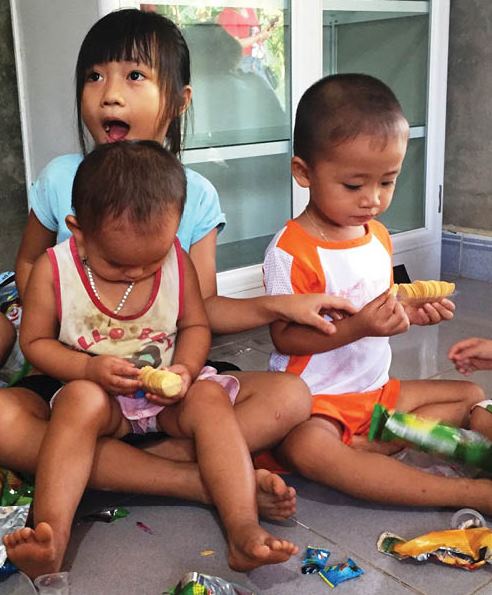
The houses of the Muong community at the foot of the hill
In the hunt for the source of life
Mrs. Dinh Thi Toan wanted to tell something after showing us her well-kept traditional Muong costume. Her eyes were filled with tears and traveled far away. It seemed that she didn't want to talk. She was sad! And this sentiment came with a reason.
As a native of ethnic minorities, but when referring to the cultural features of her people, she only has a traditional costume to show. In a despairing tone, she said, “Out of dozens of Muong people here, only do I have this costume. And, I only use it when I attend a meeting or a festival to let others know that I am a Muong ethnic”.
Part of Ray Lang is nestled in the middle of the valley, whereas some places of it were seated insecurely by the hillside with the spreading green of the trees and the murmuring sound of the stream water. My idea of this land more than 20 years ago was that it lies “in the middle of nowhere”.
Back then, the Muong community only comprised of a few isolated tents. They were foresters, who initially came here to hunt for better livelihoods, then tied the knot with this land by destiny. Mrs. Toan turned her eyes to her husband, Mr. Ha Xuan Lam (born in 1960), who currently is the deputy head of Khe Su village, giving him the stage to continue to tell me the story.
“I used to be an agarwood hunter. Because of love, I wandered here and settled down”, said Mr. Lam. About more than 25 years ago, in the Muong village in the remote Yen Lap district, where he had been living, there was a group of agarwood hunters that came back and forth.
They asked the local people for food and water after long and tough journeys. Gradually, they got to know each other. Then several Muong villagers, including Mr. Lam, followed the group to rove and became “apprentices”. The series of hunts had later led Mr. Lam and the group of men to set their steps at the foot of Bach Ma Mountain, a place that is thousands of miles from their homeland.
“As agarwood hunters, we live a vagabond life. We rummage everywhere in the border forests for a living. In 1995, our group came to Bach Ma and planned to take a cross-border trip to Laos to look for agarwood. However, having heard that many people had died from such trips, I and Mr. Dinh Van Giap (also from the Muong ethnic group) decided not to go. Instead, we stayed here and started from scratch right in the land that we are now living”, said Mr. Lam.

Mr. Ha Xuan Lam improves his income by planting crops and breeding animals
Two years after determining Bach Ma Mountain their new home, Mr. Lam and Mr. Giap returned to their hometown to take their wife and children here. They had their tents set up in the amazement of the local people.
The locals did not know where this group of people came from, what ethnicity they were and why they lived in such a place that was almost isolated at that time. The local government was also in total confusion. From a few people, the group suddenly became a small community of Muong people. They called their new home Ray Lang.
On a business trip to Thua Thien Hue in 2002, former Party General Secretary Nong Duc Manh, when learned that a group of Muong people had come to settle down at the foot of Bach Ma Mountain, instructed the local authorities to assist them to integrate into the local community.
Thanks to that, Loc Tri commune authorities permitted the Muong community to expand and reclaim their land and formally set up their village. Each household was also granted 1,000m2 of land for cultivation and budget to build a stable house. The seven houses erected at that time have still been inhabited by the Muong community at the foot of Bach Ma until now ...

The younger generation of Muong people born at the foot of Bach Ma Mountain fueling the desire of changes
A new dawn
Gazing up behind those concrete houses set up with the support from the State in that year, our eyes will be conquered by the immense green of acacia. Zooming a bit farther, we’ll see the peak of Bach Ma concealed in clouds. The memory of the old days of the Muong people here is actually a series of worries and troubles.
Accompanying me that day was Ms. Phuc - a teacher of a junior high school in Phu Loc district. She said that her charity group had many times visited Ray Lang, even the houses that were anchored on the hillside, to give gifts and organize Mid-Autumn festivals for the Muong children.
Having been here many times before, Ms. Phuc is the person who knows best about this full-of-hardship land. Every time she comes here, she brings back with her the obsession about those little kids with dusky skin and illiteracy playing on the hillside.
But this time, walking on the shady and winding concrete roads at the foot of the mountain, she and I both thought about positive changes. Ms. Phuc talked about the tourism projects at the foot of Bach Ma mountain that have benefited the Muong community. Those roads have removed the isolation. But the biggest change is indeed the local people's thinking in terms of economic development.
Mr. Lam boasted about the line of coconut trees and around 50 3-year-old grapefruit trees that he was supported as a part of sustainable livelihood development by a project. “Compared to 10 years ago, this place has incredibly changed. Electricity, roads, schools, and stations (public facilities) are all available. People know how to raise cows and pigs to gain capital and set up garden to breed fruit trees. The land here is fertile. That why I chose this place to settle down. After many years of "struggling" with every inch of land, now I feel the harvest time has come,” Mr. Lam shared.
From only two tents at the start, the Muong community at the foot of Bach Ma has developed to 12 households with nearly 60 people. When the State granted them land and helped them build houses to promote production, most of the households here have escaped poverty and stabilized their livelihoods.
Like Mr. Lam, the life of Mr. Giap and his family was also tough. Their house used to be anchored on the mountainside. Now, however, thanks to their reclamation efforts, they have had 3ha of forest in hand from which they could earn VND 4 to 5 million a month.
Not only stabilizing life, many generations of the Muong people in Ray Lang have also learned how to read books and calculate numbers. Considering that more than ten years ago, even writing a name would be a big challenge for them, what they could do now is truly a miracle.
At present, the Muong people at the foot of Bach Ma have merged with the local people. Their journey for survival that year has gone with the past. From the mountain, amongst the vast green, all the roads and paths are wide and open – just like the future of the Muong people in Ray Lang.
Story and photos: Son Xuan